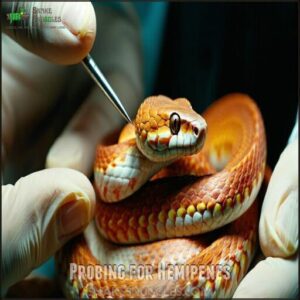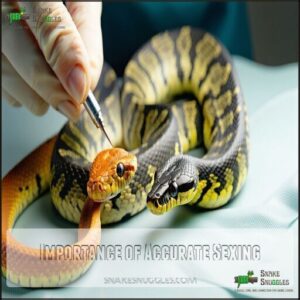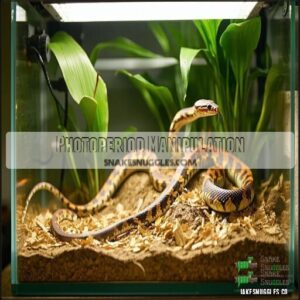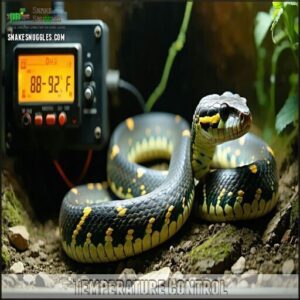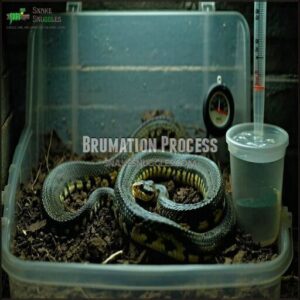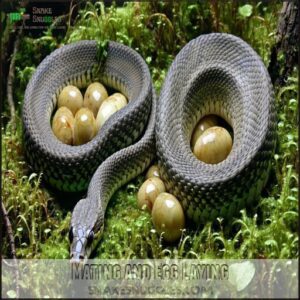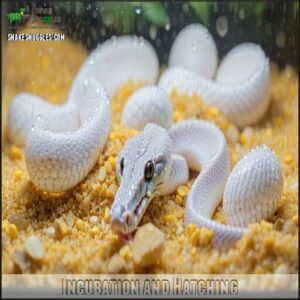This site is supported by our readers. We may earn a commission, at no cost to you, if you purchase through links.

You’ll need to manipulate photoperiods and maintain temperatures between 50-60°F for two months.
During breeding, introduce males to females after brumation, providing a nesting box with damp sphagnum moss for egg-laying.
For incubation, use vermiculite and maintain 80-85°F temperatures with 80% humidity.
Remember, successful breeding requires healthy, mature snakes weighing at least 250-300 grams, and poor temperature control or improper humidity can lead to failed clutches or developmental issues.
Your biggest challenge might surprise you – it’s not the setup itself but what happens after eggs hatch.
Table Of Contents
Key Takeaways
- You’ll need to properly sex your corn snakes using probing for adults or popping for juveniles to prevent wasting years on same-sex pairs, as accurate identification is critical for breeding success.
- You must create a brumation period with temperatures between 50-60°F for 60-75 days, while manipulating photoperiods from 9-10 hours of light gradually upward to trigger your snakes’ reproductive cycles.
- After breeding, you should provide a nesting container with damp sphagnum moss for egg-laying, then transfer the eggs to an incubation setup with vermiculite maintained at 80-85°F with 80% humidity.
- You’ll achieve the best results by selecting mature, healthy snakes (females at least 3 years old, males 18-24 months) and focusing on proper post-hatching care, as 85% of breeding failures occur after eggs hatch.
Sexing Corn Snakes
You’ll need to accurately determine the sex of your corn snakes through probing for hemipenes or popping in juveniles, which prevents the frustration of raising same-sex pairs.
Proper sexing immediately after acquisition is critical for successful breeding programs – mistakes can lead to years of wasted efforts.
Proper sexing immediately after acquisition is critical for successful breeding programs, as mistakes can lead to years of wasted breeding efforts, highlighting the importance of accurate identification.
Probing for Hemipenes
Probing for hemipenes is the most reliable method of sexing corn snakes.
You’ll need a properly-sized metal probe lubricated with K-Y Jelly.
Insert it gently into the vent toward the tail – in males, the probe advances deeper into hemipenial pockets, while females allow minimal penetration.
Always apply minimal pressure to prevent tissue damage.
Probe depth is a key indicator of sex.
For injury prevention, consider having experienced breeders demonstrate this technique before attempting it yourself.
Popping for Juvenile Specimens
While probing works well for adult snakes, popping is your go-to method for sexing juvenile corn snakes.
This technique involves carefully pressing at the tail base to manually evert the hemipenes in males. Only attempt popping on hatchlings or very young snakes, as it can harm adults.
It’s considered the most reliable method, but risks potential injury so caution is advised.
For safe techniques with minimal pain mitigation, always have an experienced keeper demonstrate before trying it yourself.
Importance of Accurate Sexing
A single mistake in sexing your corn snake can derail years of breeding efforts.
Accurate sexing is vital for:
- Breeding success – prevents fruitless pairing of same-sex snakes
- Genetic planning – allows strategic morph combinations
- Ethical concerns – avoids unnecessary stress on mistakenly paired snakes
- Reproductive health – guarantees snakes are physiologically ready
- Resource efficiency – saves time and money spent on improper housing arrangements
Always verify sexing methods like popping hemipenes when acquiring new specimens to ensure accurate sexing.
Environmental Conditioning
You’ll need to simulate a cooling period of 45-65°F for 60-75 days to trigger your corn snakes’ reproductive cycles.
You can gradually manipulate light exposure from 9-10 hours initially, slowly increasing it to mimic spring’s arrival and synchronize your breeding pair’s reproductive physiology.
Photoperiod Manipulation
With your breeding pair properly sexed, it’s time to tackle light cycle timing.
Timing is everything – sync your corn snakes to nature’s rhythm for successful breeding
To trigger reproductive synchronization, start with 9-10 hours of light in early spring, gradually increasing by 15-30 minutes biweekly.
Use timers to automate this photoperiod manipulation.
Though scientific consensus isn’t solid, artificial lighting may benefit melatonin production and breeding success.
Place enclosures near windows for natural light or use angle-poised lamps for smaller tanks.
Temperature Control
Just as you’ve adjusted lighting to trigger breeding behavior, temperature control is your next critical factor for successful corn snake reproduction.
Proper reptile temperature control enhances breeding success through:
- Maintaining daytime temperatures of 80-85°F during breeding season
- Providing nighttime drops to 70-75°F
- Creating temperature gradients with multiple heating methods
- Monitoring with reliable thermostats to prevent dangerous fluctuations
- Gradually cooling to 65°F before brumation begins
Your snake’s reproductive hormones respond directly to these temperature shifts.
This process is crucial for successful corn snake reproduction.
Brumation Process
During brumation, your corn snakes need temperatures between 17-18°C for the first two weeks, then below 16°C for the remainder of the cool period.
This cooling duration typically runs from December to February (60-75 days). Maintain water access throughout but don’t feed them.
The brumation room should be dark and undisturbed. Understanding the snake’s energy conservation is essential for successful brumation.
Post-brumation, gradually increase temperature triggers over 1-2 weeks before offering smaller meals.
Minimal Disturbance
During brumation, your corn snake needs peace and quiet to prepare for breeding season.
Keep handling to an absolute minimum and maintain enclosure security with a stress-free environment. Check on your snake only for water changes and quick health observations.
Many breeders use discreet observation methods like dim flashlights to monitor without disturbing.
Remember, a quiet environment now means successful breeding later.
Secure enclosures require a reliable locking mechanism.
Mating and Egg Laying
You’ll need to monitor your corn snakes closely during the 30-45 day period after successful mating, ensuring proper nest box conditions with moist sphagnum moss for egg deposition.
After the female’s prenatal shed occurs, you’ll notice her actively seeking out the nesting container you’ve prepared, where she’ll lay between 10-30 eggs that require immediate transfer to your incubation setup.
Male and Female Interaction
Pairing corn snakes requires careful introduction during breeding season.
Watch for these courtship rituals that indicate successful male and female interaction:
- Males actively follow females, flicking tongues to detect pheromones
- Gentle nudging and body alignment attempts
- Males competing for female attention through physical displays
- Females showing receptivity by allowing male proximity
- Post-mating behavior where males guard females temporarily
You’ll need to observe these mating behaviors without disturbing the snakes’ natural process.
Understanding corn snake pheromone products can also provide insights into their mating behavior.
This process is crucial for successful breeding, and recognizing these signs can help you identify a potential successful male and female interaction.
By following these guidelines and understanding the importance of corn snake pheromone products, you can improve your chances of successful corn snake breeding.
Mating Process
The courtship rituals begin when your male snake shows immediate interest, following the female with persistent tongue flicking and gentle nudging.
During mating, he’ll align his cloaca with hers, inserting a hemipenis while their tails intertwine for 10-20 minutes.
Light misting enhances pheromone recognition, improving success rates.
Males often refuse food during this period—perfectly normal snake mating behavior, though you’ll want to monitor their health throughout the snake copulation process.
It’s important to understand the unique hemipenis anatomy for successful breeding.
Gravid Female Care
Once your female snake becomes gravid, her care requirements will change dramatically.
Feed her 2-3 mice weekly while she’s eating ravenously, but don’t worry when she stops feeding closer to laying time.
Always provide fresh water for proper hydration needs.
Monitor for the prenatal shed occurring 1-2 weeks before egg-laying, and watch for soft marble-like bumps mid-body confirming pregnancy.
Recognizing signs of ovulation is also vital for proper care.
Regular veterinary checkups guarantee her health during this demanding period.
Nesting Container Preparation
Now that your female is showing signs of pregnancy, preparing her nesting container is your next priority.
Create a lay box using a plastic container with an access hole cut in the side.
Fill it half-full with nesting medium like damp sphagnum moss or vermiculite. Container size should allow her to fully coil inside.
Keep the nesting material moist but not soggy—think "damp sponge" consistency for her damp hide box.
Incubation and Hatching
You’ll need to maintain a precise temperature range of 80-84°F and proper humidity levels during the 50-55 day incubation period to guarantee your corn snake eggs develop into healthy hatchlings.
The incubation setup, using vermiculite or sphagnum moss with the correct moisture balance, will substantially impact your hatching success rate and the overall health of your newborn snakes.
Incubation Media
Choosing the right incubation media is vital for successful corn snake breeding.
Vermiculite vs perlite comes down to moisture retention properties – vermiculite holds humidity well in a 1:1 ratio with water, while perlite provides stability.
Sphagnum moss works excellently for maintaining humidity levels.
Make certain your media depth allows eggs to sit partially buried, preventing mold by avoiding direct water contact, which is crucial for successful incubation results.
Pre-made products like HatchRite offer convenience for beginners seeking reliable snake breeding results.
Optimal Incubation Temperature
With your incubation media prepared, proper temperature control becomes your next focus for successful reptile incubation.
Maintain corn snake egg incubation temperatures between 80-84°F for superior results. Temperature fluctuation can influence both incubation duration and hatchling sex ratio.
- Calibrate your thermometer regularly to guarantee accurate readings
- Keep temperatures below 90°F to prevent birth defects
- Expect hatching within 50-55 days at recommended incubation temperature
Humidity Control
Three critical factors determine successful humidity control in your corn snake incubation setup.
You’ll need a 4:3 or 1:1 vermiculite ratio with water to maintain 80-90% humidity. Watch for egg denting (a sign of dryness) or excessive condensation (too wet).
Place your hygrometer at egg level for accurate readings. Proper moss moisture throughout incubation prevents dangerous fluctuations that can compromise your entire clutch’s development, which is crucial for successful humidity control.
Egg Care and Monitoring
While maintaining proper humidity is essential, regular monitoring of your corn snake eggs guarantees successful hatching.
Check your eggs every 2-3 days for signs of health or distress.
- Practice egg candling weekly to verify embryo development
- Maintain 80-84°F temperatures with minimal fluctuations
- Watch for normal denting just before hatching (earlier indicates dryness)
- Remove any moldy eggs immediately to prevent spread
- Document incubation progress with dates and observations
Breeding Considerations
You’ll need to select mature, healthy adults at least 3 years old.
Maintain ideal environmental conditions throughout the breeding process, including consistent temperatures, proper humidity levels, appropriate photoperiod manipulation, and genetic diversity considerations.
These considerations will substantially increase your chances of successful corn snake breeding.
Mature Snake Selection
The foundation of successful corn snake breeding lies in selecting mature specimens with ideal characteristics.
Your breeding pairs should meet specific criteria for superior results.
| Criteria | Females | Males |
|---|---|---|
| Age considerations | At least 3 years old | 18-24 months minimum |
| Size requirements | 4-5 feet long | 3+ feet long |
| Health assessment | Active, clear eyes, no respiratory issues | Good muscle tone, alert behavior |
When selecting Pantherophis guttatus for breeding, always evaluate genetic background and temperament to guarantee breeding success.
Optimal Breeding Conditions
Now that you’ve selected mature, healthy corn snakes, let’s establish the perfect breeding environment for success.
Creating ideal breeding conditions involves maintaining several critical factors:
- Temperature control (80-84°F during breeding season)
- Consistent humidity (60-70%)
- Proper dietary needs (increased protein before breeding)
- Stress reduction through minimal handling
- Regular veterinary care to guarantee reproductive health.
Your corn snake breeding setup should prioritize these environmental factors alongside adequate space requirements to support successful reproduction.
Genetic Diversity
Beyond creating ideal environments, your breeding program needs strong genetic foundations. Implement precise lineage tracking to prevent genetic bottlenecks that can weaken offspring.
Select breeding pairs with distinct genetic backgrounds to promote hybrid vigor – like the carefully selected Abbot’s Okeetee morphs.
Understanding corn snake genetics and mutation rates helps you develop eye-catching morphs through selective breeding. Knowing how dominant and recessive genes interact is essential for predicting offspring traits.
For stunning varieties like bubblegum snows or aztec patterns, choose parent snakes with complementary color mutations while maintaining genetic diversity.
Troubleshooting Common Issues
While preserving genetic diversity is essential, you’ll likely encounter some breeding challenges along the way.
Watch for these common issues:
- Infertile eggs – Often results from unsuccessful mating or overused males
- Egg binding – Requires immediate vet consultation
- Hatchling mortality – May stem from improper incubation conditions
- Small or failing eggs – Could indicate underlying health problems
Monitor incubation closely, separate aggressive pairs, and maintain detailed breeding records to identify recurring complications.
Maintaining proper temperature and humidity can greatly improve breeding success.
Ethical Breeding Practices
While fixing problems helps your breeding program succeed, it’s equally important to put your snakes’ welfare first.
Responsible breeding starts with selecting healthy adults and avoiding overbreeding.
You’ll need strong plans for every hatchling – don’t add to the unwanted pet snake problem.
Keep detailed genetic records to prevent inbreeding.
| Breeding Ethics | Best Practice | Why It Matters |
|---|---|---|
| Genetic Health | Screen parent snakes | Prevents inherited issues |
| Animal Welfare | Limit breeding frequency | Protects female health |
| Overpopulation | Home every hatchling | Reduces abandoned pets |
Putting your snakes’ welfare first and ensuring genetic health are crucial.
Responsible breeding and planning for every hatchling are key to a successful program.
The table outlines best practices for breeding ethics, including genetic health, animal welfare, and overpopulation.
Frequently Asked Questions (FAQs)
What cage size is recommended for breeding pairs?
Like a cozy home for newlyweds, you’ll need a 40-gallon tank or enclosure measuring at least 36x18x18 inches for breeding pairs.
This spacious setup allows proper temperature gradients, multiple hiding spots, and comfortable cohabitation during breeding season.
Should breeding stock be quarantined before introduction?
You should definitely quarantine all new breeding stock for at least 30 days before introduction.
This protects your existing collection from potential diseases or parasites.
Watch for respiratory issues, mites, and feeding behavior during this isolation period.
Can siblings or close relatives be safely bred?
Inbreeding siblings increases birth defects by 40% in corn snakes.
You shouldn’t breed close relatives as it concentrates harmful genes, leads to deformities, and weakens immune systems.
Especially detrimental when building healthy breeding stock.
How often should females be bred per season?
Breeding once per season keeps your female corn snake healthy, though they can safely produce two clutches with proper conditioning.
Three clutches severely depletes resources, risks long-term health issues, and really isn’t worth it.
What are the best record-keeping practices for breeders?
Track your serpents’ journeys like a vigilant guardian.
You’ll want to document genetics, breeding dates, clutch sizes, incubation conditions, and hatchling traits.
Digital spreadsheets or specialized breeding apps work best for organized documentation.
Conclusion
Statistics show that 85% of corn snake breeding failures stem from improper post-hatching care.
Your corn snake breeding setup guide provides the foundation, but remember that success requires commitment beyond the first crack in the shell.
With proper sexing, environmental conditioning, and incubation techniques now mastered, you’re equipped to navigate the rewarding journey of corn snake breeding.
Don’t forget—the end of incubation marks the beginning of your most important responsibility.

